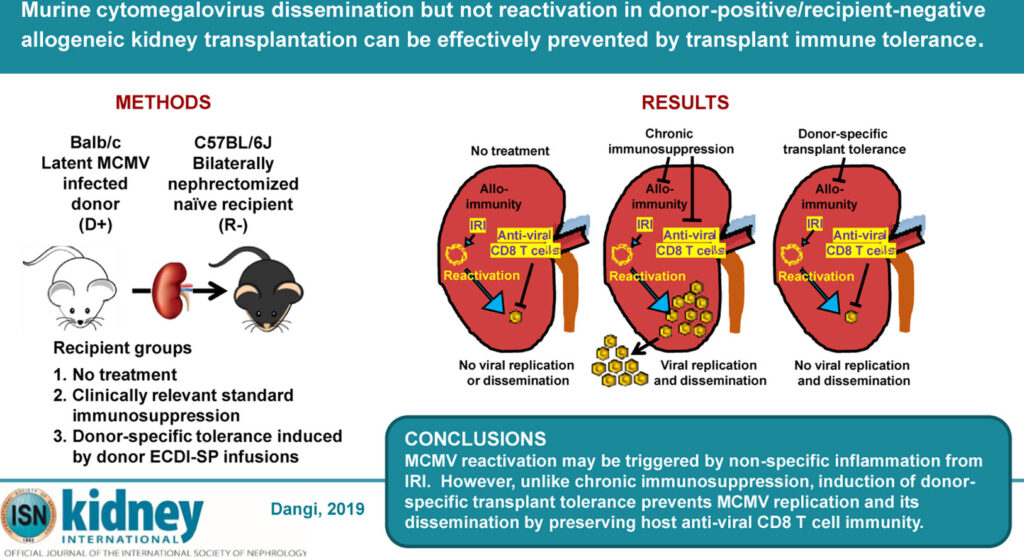Cytomegalovirus (CMV) remains one of the most significant viral infections in renal transplant recipients. CMV infection following kidney transplantation not only causes direct disease but also contributes to indirect effects such as acute rejection, graft dysfunction, and opportunistic infections. Effective prevention of CMV disease after kidney transplantation is critical for improving both short-term and long-term transplant outcomes.
Our approach focuses on risk stratification, targeted antiviral prophylaxis, preemptive therapy, and ongoing viral load surveillance to prevent CMV-associated complications.

CMV Risk Stratification in Renal Transplantation
The foundation of prevention begins with identifying patient risk using donor (D) and recipient (R) serostatus:
| Donor | Recipient | Risk Classification |
|---|---|---|
| D+/R− | High | |
| D+/R+ | Intermediate | |
| D−/R+ | Intermediate | |
| D−/R− | Low |
- High-risk (D+/R−) patients are susceptible to primary CMV infection with no pre-existing immunity.
- Intermediate-risk patients are prone to reactivation or reinfection.
- Low-risk patients have the lowest incidence and generally do not require antiviral prophylaxis.
Antiviral Prophylaxis for CMV Prevention in Kidney Transplants
Valganciclovir
- Preferred agent for CMV prophylaxis in kidney transplant recipients.
- Standard dose: 900 mg orally once daily, adjusted for renal function.
- Duration:
- High-risk (D+/R−): 6 months
- Intermediate-risk: 3 months
Valganciclovir significantly reduces the risk of CMV syndrome, invasive disease, and associated complications such as graft rejection.
Ganciclovir (Intravenous)
- Used in cases where oral intake is compromised.
- Dose: 5 mg/kg IV every 12 hours during induction, then adjusted as needed.
- Reserved for critically ill or hospitalized patients.
Preemptive Therapy Approach Based on CMV PCR Monitoring
Preemptive therapy is a cost-effective strategy for intermediate-risk or low-risk recipients. This involves regular monitoring of CMV viremia and initiating antiviral treatment when a specific viral load threshold is reached—before clinical disease manifests.
Protocol
- Monitoring: Weekly CMV PCR testing for the first 3–4 months post-transplant.
- Threshold: Viral load >1000 IU/mL (institution-specific)
- Treatment: Initiate valganciclovir 900 mg BID until two consecutive negative results
This strategy requires timely diagnostics and infrastructure but minimizes unnecessary drug exposure.
Monitoring Strategies to Prevent CMV Disease
Quantitative CMV PCR
- Highly sensitive and specific
- Detects asymptomatic replication
- Guides initiation and cessation of therapy in preemptive settings
CMV-Specific Immunity Assays
- QuantiFERON-CMV or CMV ELISPOT
- Evaluates host immune competence against CMV
- Helps predict late-onset disease or tailor prophylaxis duration
Immunosuppression and CMV Risk Modulation
Over-immunosuppression is a key risk factor for CMV disease. The intensity of induction and maintenance regimens influences infection rates.
Key Factors:
- Depleting agents like anti-thymocyte globulin (ATG) raise CMV risk
- Mycophenolate mofetil (MMF) increases susceptibility to CMV
- Steroid minimization protocols may lower CMV incidence
Close coordination between transplant and infectious disease teams is essential for immunosuppressive dose balancing.
Managing CMV in High-Risk (D+/R−) Kidney Transplant Recipients
High-risk patients benefit most from extended prophylaxis and enhanced monitoring:
- Valganciclovir for 6 months post-transplant
- Monthly PCR surveillance for 3–6 months after stopping prophylaxis
- Consider secondary prophylaxis following treatment of CMV disease
Late-Onset CMV Disease: Prevention and Mitigation
Late-onset CMV disease can occur after discontinuation of prophylaxis, particularly in high-risk recipients or those receiving lymphocyte-depleting agents.
Prevention Tactics:
- Extended prophylaxis up to 200 days
- Post-prophylaxis PCR surveillance
- Use of immune monitoring to individualize cessation of therapy
Alternative and Emerging Therapies
Letermovir
- Novel antiviral agent targeting CMV terminase complex
- Approved in stem cell transplant settings
- Promising off-label use in solid organ transplants, especially for valganciclovir-intolerant patients
CMV-Specific Immunoglobulin (CMV-IVIG)
- Used as adjunct in severe CMV disease
- May benefit high-risk patients post-treatment
- Limited data in prophylactic use; not standard
Frequently Asked Questions
What is the optimal prophylaxis duration after kidney transplantation?
- 6 months for high-risk (D+/R−)
- 3 months for intermediate-risk (D+/R+ or D−/R+)
- Low-risk patients generally require no prophylaxis
Can CMV cause graft rejection?
Yes, CMV is linked to acute rejection and interstitial fibrosis through immune activation and inflammatory cytokine release.
What are the clinical signs of CMV disease?
- Fever, malaise, leukopenia
- Gastrointestinal symptoms (diarrhea, colitis)
- Pneumonitis or hepatitis in tissue-invasive cases
How is late-onset CMV detected?
Through routine CMV PCR monitoring after prophylaxis ends. Symptoms may lag behind viral replication, making surveillance crucial.
Is preemptive therapy as effective as prophylaxis?
In intermediate-risk patients with strong follow-up systems, preemptive therapy is a safe and effective alternative to universal prophylaxis.
Preventing CMV disease after kidney transplantation requires a risk-adapted strategy that includes antiviral prophylaxis, PCR surveillance, immunologic assessment, and early therapeutic intervention. High-risk patients benefit from extended prophylaxis, while intermediate-risk patients may be managed effectively through preemptive therapy. Integration of new diagnostics and antivirals will continue to enhance CMV prevention and optimize graft survival.